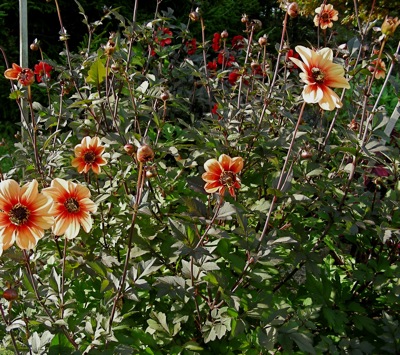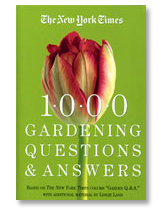Dahlias with Dark Foliage: growing Bishop’s Children from seed and getting hooked on Black Leaves
First the good news: There’s no bad news. Dahlias are easy to grow from seed; dark foliage gives Bishop’s Children a striking presence that doesn’t depend on the flowers; and a single packet of seeds is a plant explorer’s cheap thrill: you never know what you’re going to get but you’re bound to get something worth keeping and keeping dahlias is easy too.
In my experience, flowers come mostly in red-orange and deep reds like the one above the rock wall. Foliage is mostly that same purple and mostly dahlia shaped.
But
Came from the same packet, so you never know. You can’t really tell from the picture but the leaves on this plant are deeply cut, almost scalloped, and as you can tell they’re a lot paler.
To get flowers the first year, start seeds early (mid-March if you’re in zone 5). Use a fast draining seed starting mix; barely cover the seeds and keep the usual “moist but not wet.” They should sprout in a week or ten days at 70 degrees.
After that the seedling usual continues: Give them bright light but not burning sun; transplant into small pots or large cells when they have 2-3 sets of true leaves and then again as necessary as roots get crowded. Pinch after 4 or 5 sets of true leaves to promote bushiness.
Since it’s always sensible to sow more seeds than you want plants, it’s likely there will be too many and you’ll have to choose which seedlings to keep. At this point, the usual breaks down. The Darwinian model that works for vegetables isn’t as useful for mixed flowers.
Spotting the fittest early is easy: they germinated first; they’re stockier; the leaves are greener. A general aura of vigor is unmistakable. Unfortunately, when you’re working with this kind of genetic salad there’s always a chance ( a good chance, as far as I can tell) that unusual colors and shapes will be weaker – at least in the seedling stage – than their more common fellows. Yet the obverse doesn’t apply – most of the weaklings won’t be worth saving. I have no solution to this problem; it’s essentially one of risk tolerance and we’ve all been looking at that a little too much lately as it is.
So. Feed the babies some half-strength all purpose fertilizer when they’re about 2 months old. Harden off before setting out in full sun in very fertile, very fast-draining soil, then let ’em rip. Bishop’s Children don’t start blooming as early as dwarf bedding dahlias like Rigoletto, but they should start flowering around mid August and keep it up until frost.
The first year, it’s wise to dig plants you want to keep before frost kills the stems and leaves. Just as vigor is no predictor of beauty, beauty is no predictor of tubers and you may find your prettiest plant is essentially tuber-free. If you know in time, you can pot them up or take cuttings to root.
Nomenclatural note:
If you get something worth preserving you might want to call it Aunt Sue. The Bishop who had the children is Bishop of Llandaff, which was introduced as Bishop Hughes, after the incumbent at the time (1927). His Grace was not pleased. “It is reported the namesake preferred the name be changed, and consequently it was next called ‘The Bishop’. However, modern rules of nomenclature forbade (and still forbids (sic)) use of articles in cultivar names. Consequently it was again renamed to simply ‘Bishop of Llandaff’. ”
Skip forward about 75 years. Several of the Bishop’s Children have been selected out, propagated and given Bishoprics in the UK: Leicester, Oxford, Canterbury and York. But the latter two are ecclesiastically incorrect, as noted in the catalog of Plant Delights Nursery, which sells all four of them as well as the original Welsh guy. Canterbury and York don’t have Bishops. They have Archbishops. Big difference, although as far as I know there’ve been no complaints from the Church.
The tidbit about Bishop of Llandaff is from The Stanford Dahlia Project (Stanford University), where you can learn a LOT about dahlias and also find links to several humongous dahlia sites that link to other humongous dahlia sites in that horribly endless way that totally shoots your morning.
And possibly afternoon as well. Don’t say I didn’t warn you. Myself, I’m concentrating my time on Stanford’s dahlia supplier, Corralitos Gardens. Eighteen (!) dark leafed dahlias, only one ordained (Auckland, which seems to be on the up and up).


















Thanks. Kept me from looking out the window on this snowed Friday.
Do you think the seeds would respond to winter sowing? I had wonderful luck on the back porch (outside, uncovered) last winter — with hollyhocks, California and Iceland poppies.
Best,
Leo
Leslie! That was a feast forthe eyes on this sleet filled day! They sound great but I am wondering about the occurrence of powdery mildew on the leaves in humid and randomly wet/dry locations like NJ. You probably have similar moisture issues though not the bone searing heat we have had the last few summers. Any insight? Other dark leaved plant material frequently suffers after a great start. Have a great weekend.
Welcome to you both.
Leo – Congratulations on your success with the hollyhocks and poppies, plants that germinate well and start growing early when given a cold spell. They’re great candidates for fall sowing, so I’m not surprised to hear the winter porch trick worked out.
But if you have snow, you don’t have the right climate for sowing dahlia seeds outdoors. Dahlias aren’t hardy north of zone 8, and that’s just the limit for mulching the tubers and leaving them in the ground. The seeds need warmth to sprout and the plants need warmth to grow, so if you want to give them a head start you’re stuck doing it indoors.
Bramble – glad you enjoyed the photos. All I can say about powdery mildew is that my dark leaved dahlias have never had any – not the slightest trace. They’re in Maine, which is more flower-friendly than NJ, but the many dahlias I grow in NY, where conditions are somewhat more like yours, have never had any mildew either. Given that the NY cosmos, phlox and other mildew-magnets are not infrequently disgusting I’d say plant type probably trumps leaf color. If your other dahlias have been healthy I’ll bet the dark leafed ones will be too.
Hi,
I would like to have a dark foliage red dahila about 4′ tall.can anyone tell me where to find one
haryherr@hotmail.com
Hi Harry,
There are a couple of choices at the nurseries linked above.
Bishop of Llandaff ( sold by Plant Delights) is red – sometimes leaning slightly toward orange. It’s probably your best bet if height is important; it’s among the tallest of the named dark leaf varieties. The alternative is Bishop of Auckland, available from both Plant Delights and Corralitos. Auckland’s flowers are a deeper red and the foliage is very dark, but the plant is a bit shorter than Llandaff and unlikely to hit 4 feet (although you never know).